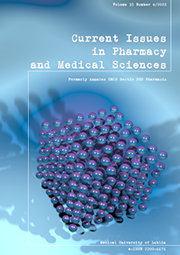The study of fatty acid composition in Cockscomb (Сelosia cristata (L.) Kuntze)
DOI:
https://doi.org/10.2478/cipms-2022-0032Keywords:
fatty acids, Сelosia cristata, Amaranthaceae, GC methodAbstract
Cockscomb (Сelosia cristata (L.) Kuntze) is a well-known decorative plant belonging to the Amaranthaceae L. family. It is used in South East Asia folk medicine as an anesthetic, anti-microbial, hemostatic, tonic and anti-inflammatory drug. Some 11 to 12 fatty acids have been identified in cockscomb roots, leaves, stem, herb, flowers and seeds, and their quantitative content has been determined by gas chromatography. Accordingly, in all herb samples, unsaturated fatty acids dominated, forming 68.18 to 75.93% of total content. Mostly, these compounds were accumulated in the roots. Among the unsaturated fatty acids, linoleic acid prevailed in roots, stems, herb, flowers and seeds, whereas linolenic acid prevailed in the leaves. The highest content of linoleic acid (45.57±1.14%) was found in the seeds, while that of linolenic acid (53.63±0.53%) was found in the leaves.
The obtained results will be applied in the development of drugs on the basis of cockscomb herb lipophilic fraction.
References
1. Yates CM, Calder PC, Ed Rainger G. Pharmacology and therapeutics of omega-3 polyunsaturated fatty acids in chronic inflammatory disease. Pharmacol Ther. 2014;141(3):272-82. Review match
2. Rustan AC, Drevon CA. Fatty acids: Structures and properties. ELS. 2005;1:7.
3. Al-shahery YJ, Alasady IN. Identification of saturated and unsaturated fatty acids produced by chlorella vulgaris as a potential candidate for biodiesel production. Trop J Nat Prod Res. 2021;5(2): 238-42. Review match
4. Mastuti R, Arumingtyas EL, Fatinah AA. Genetic diversity of Celosia variants in east java based on polyphenol oxidase-PPO genes. Procedia Chem. 2015;14:361-6. Review match
5. Muhallilin I, Aisyah SI, Sukma D. The diversity of morphological characteristics and chemical content of Celosia cristata plantlets due to gamma ray irradiation. Biodiversitas. 2019;20(3):862-6. Review match
6. Surse SN, Shrivastava B, Sharma P, Sharma J, Gide PS. Pharmacognostic standardisation of whole plant of Celosia argentea, var. cristata (L). Int J Pharm Res Scholars. 2014;3(3):387-92.
7. Gaibimei P, Yousuf O, Singh A, Devi NM. A study on phytochemical screening of Celosia argentea var. cristata inflorescence extract. Pharm Innov J. 2018;7(10):284-7.
8. Varadharaj V, Muniyappan J. Phytochemical and phytotherapeutic properties of Celosia species – A review. Intern J Pharmacogn Phytochem Res. 2017;9(6):820-5. Review match
9. Xiang C, Meili G, Hui S, Ya DC. Study on chemical constituents of Celosia cristata seed. J Jilin Agric Univ. 2010;32:657-60.
10. Ramesh BN, Mahalakshmi AM, Mallappa S. Towards a better understanding of an updated ethnopharmacology of Celosia argentea L. Intern J Pharm Pharm Sci. 2013;5(3):54-9.
11. Sayeed R, Thakur M, Gani A. Celosia cristata Linn. flowers as a new source of nutraceuticals – A study on nutritional composition, chemical characterization and in-vitro antioxidant capacity. Heliyon. 2020;6:05792-800. Review match
12. Sultan FI. Chromatographic separation and identification of many fatty acids and phenolic compounds from flowers of celosia cristata L. and its inhibitory effect on some pathogenic bacteria. Austr J Basic Appl Sci. 2018;12 (7):25-31. Review match
13. Al-Snafi AE. Oils and fats contents of medicinal plants, as natural ingredients for many therapeutic purposes – A review. J Pharm. 2020;10(7):41.
14. Tang Y, Xin H, Guo M. Review on research of the phytochemistry and pharmacological activities of Celosia argentea. Revista Brasileira de Farmacognosia. 2016;26 (6):787-96. Review match
15. Nengroo ZR, Rauf A. Fatty acid composition and antioxidant activities of five medicinal plants from Kashmir. Industr Crops Prod. 2019;140:111596-602. Review match
16. Ogungbenle HN., Sanusi DS. Extraction, physicochemical, phytosterols and fatty acid of Celosia spicata leaves. British J Res. 2015;2:9-20.
17. Islam S, Shaji MS, Ahmed T. Antinociceptive effect of methanol extract of Celosia cristata Linn. in mice. BMC Complement Altern Med. 2016;16:400-14. Review match
18. Fatimah IS. Chromatographic separation and identification of many fatty acids and phenolic compounds from flowers of Celosia cristata L. and its inhibitory effect on some pathogenic bacteria. Austr J Basic Appl Sci. 2018;12 (7):25-31. Review match
19. Kyslychenko OA, Protska VV, Zhuravel IO, Hutsol VV. The study of Daucus carota subsp. sativus fruits fatty acid composition of “Olenka”, “Kharkivska Nantska” and “Yaskrava” varieties. Res J Pharm Biol Chem Sci. 2018;9(6):307-12. Review match
20. Dababneh MF, Protska VV, Zhuravel IO. Analysis of fatty acid composition of rhizomes with roots, leaves and flovers of Hosta Plantaginea. Res J Pharm Biol Chem Sci. 2016;7(6):2251-5.
Downloads
Published
Issue
Section
License
Copyright (c) 2023 Authors

This work is licensed under a Creative Commons Attribution-NonCommercial-NoDerivatives 3.0 Unported License.


